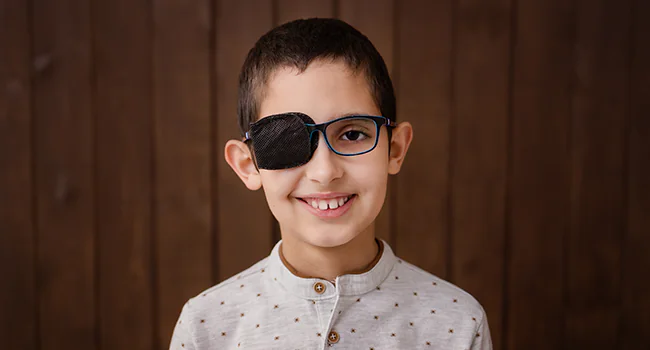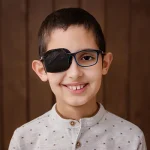Everyone is aware that children learn through their eyes. Therefore, having good vision is essential for children to read, write, and play. It involves more than just sharp near- and far-sighted vision. Eyes also let you retain elements of what you read to see the story in your mind and help you distinguish similar characters, such as “b” and “d,” from one another. But what if a child feels like they can only see things clearly with one eye?
Well, then the situation becomes serious as it could be that the child is suffering from Lazy Eyes. Keep reading this page to know all about it.
What Are Lazy Eyes?
Let’s begin with the basic definition, as the term is unique. Amblyopia, or lazy eye, is a disorder that affects young children where one of their eyes does not develop normally. The brain essentially ignores the sluggish eye when a person has amblyopia because it concentrates on one eye more than the other. The nerve cells in the affected eye do not mature as they should if they do not receive the proper stimulation.
Not to ignore the fact, the eye is not lazy in this condition; hence the phrase “lazy eye” is slightly inaccurate in its literal meaning. Surprisingly, the disorder is not an issue with the eye itself but rather a developmental issue with the nerve that connects the eye to the brain.
Causes Of Lazy Eyes
A lazy eye can be brought on by anything that limits vision in either eye. The brain suppresses the images from the most afflicted eye, albeit the reasons why are unclear. Here are the two common reasons why someone could have lazy eyes.
- Strabismus
The eyes overlap or turn out due to incoordination in the muscles that position the eye. The muscular imbalance makes it challenging for both eyes to track objects simultaneously. Strabismus or squint can be inherited, brought on by near- or farsightedness, a viral infection, or an injury.
- Anisometropic Amblyopia
When light is not adequately focused as it passes through the eye’s lens, it is said to have a refractive error. Refractive errors include nearsightedness, farsightedness, or astigmatism.
Is There Any Treatment For Lazy Eyes?
Yes. It is because, in childhood, the neural circuits link the eyes to the brain are still developing. For this reason, children aged 7 and under frequently respond best to treatment for lazy eyes. The earlier you begin treatment, the more probable you will see positive outcomes.
However, adolescents up to 17 can still exhibit good outcomes. If you are older than 17 and have lazy eyes, don’t let that stop you. Talking to your doctor about your options is essential because even individuals with sluggish eyes can frequently improve their vision with treatment.
Treatments
Here are some common lazy eye treatments:
- Corrective Lens
If you’re unaware, you should know that sometimes having a different vision in each eye leads to a lazy eye. As a result, each eye’s vision becomes less acute than the other, and this is referred to as refractive amblyopia. The best solution under these circumstances is eyeglasses.
You or your child can have your eyes inspected and tested by an eye specialist, such as an ophthalmologist or optometrist, to receive eyeglasses for this condition. This is one of the best lazy eye treatments for adults as well. For corrective eyeglasses, a prescription is required, and an optometrist or optician can often make your glasses.
- Eye patches
Effective, affordable therapy for lazy eyes is to wear an eyepatch (patching for lazy eyes). It improves the weaker eye’s recovery. You should cover the better seeing eye for roughly two to five hours each day using an eyepatch. Your doctor will determine the length of time the patch should be worn.
Not to forget, it’s crucial to adhere to your doctor’s recommendations when using Amblyopia treatment patching. Long-term use of the patch may occasionally cause the stronger eye’s lazy eye to appear.
- Eye Drops
Limiting the dominant eye’s vision with medication forces the weaker eye to work harder. Atropine, is the most frequently prescribed drug. Atropine must be used following your doctor’s instructions and is only accessible with a prescription.
- Surgery
Lazy eye surgery changes the length or placement of the eye muscles. It may be used when amblyopia is brought on by a squint, droopy eyelid, or cataract. Eye patches are frequently used in conjunction with surgical treatments for lazy eyes to help correct vision. Additionally, lazy eye corrective surgery is utilized to enhance the eye’s external appearance.
One must understand that children with lazy eyes frequently go undetected. But vision loss could result from this. Hence it’s crucial to see a doctor if you think you or your child may have a lazy eye.
Overall, the problem is curable and frequently responds favourably to methods like wearing corrective glasses and an eye patch.
Why Centre For Sight?
If you’re looking forward to treatments for such eye disease, get in touch with us. Center for Sight is dedicated to improving the quality of life for millions of people by giving them the freedom to live without glasses and the delight of clean vision. Regardless of a patient’s social or financial situation, we believe in providing them with quality ophthalmology care using the most recent diagnostic and therapeutic techniques. Contact us to know more.
Article: lazy-eye-treatment-causes-and-suitable-treatment-options
Author: CFS Editorial Team | Aug 19 2022 | UPDATED 02:00 IST
*The views expressed here are solely those of the author in his private capacity and do not in any way represent the views of Centre for Sight.





